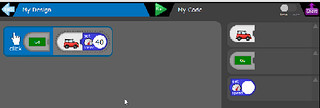This application is designed to teach Computing at Key Stages 1 and 2 (a more sophisticated version for older pupils is being worked on).
What struck me immediately on using it is the amount of guidance available, both in verbal form and videos. There is quite a large range of modules to choose from, including “Starter” ones which take you through the basics and, where appropriate, recapitulate what has already been learnt.
This will benefit not only pupils but also, of course, teachers for whom “coding” is unchartered territory.
 A large number of Units are provided.
A large number of Units are provided.
Like the other programs I’ve reviewed recently, Espresso Coding enables pupils to create programs by using code blocks. However, it seems to be only in the Year 5 modules that you can actually see the code generated behind the scenes, and even there you are unable to edit the text of the code.
 Apps are created by dragging and dropping blocks of code.
Apps are created by dragging and dropping blocks of code.
The application provides a number of Units designed to teach just one main thing, or group of things, such as Repetition and loops. Each Unit contains several lessons, so there is plenty here to ensure you won’t run out of things to do after the first lesson.
In addition, there are a few ready-made apps to show you what can be done, and several of these have detailed instructions about how to re-create them yourself.
There are also a simple glossary and a guide to which parts of the Programme of Study are covered by Espresso Coding. Unfortunately, the latter is little more than advertising puff. It would have been more useful if the Programme of Study text had been broken down and linked to specific activities/modules.
Pupils can share their completed applications with others via a unique URL if they (and their teacher) desire.
Espresso Coding doesn’t work in Firefox, but as most schools will have Internet Explorer or Chrome this should not prove to be an obstacle.
For further information, please visit http://www.espressocoding.co.uk/
This article first appeared in Digital Education, the free newsletter for those with a professional interest in educational ICT and Computing. One of the benefits of subscribing – apart from access to unique content – is articles in a timely manner. For example, this article was published in the Early July 2014 edition.To sign up, please complete the short form on our newsletter page. We use a double opt-in system, and you won’t get spammed.
I've just been informed that the link I provided for further information is not as good as this one: Further information
